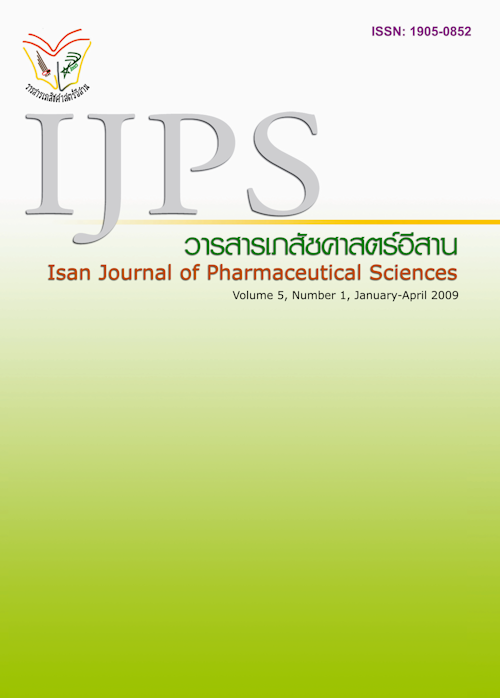Development of Oral Isoniazid and Rifampicin Microspheres
Main Article Content
Abstract
The objective of this study was to develop oral isoniazid and rifampicin microspheres in order to improve rifampicin stability by avoiding its direct contact with INH and acidic environmental of stomach. In the study, isoniazid microspheres were prepared by w/o/w emulsion solvent diffusion evaporation method using ethylcellulose as wall material. Rifampicin microspheres were prepared by o/o emulsion solvent diffusion evaporation method using Eudragit®L 100-55 as polymer. Formulation variables which effect physical characteristic and microsphere stability were investigated. Result from differential scanning calorimetry showed that isoniazid and rifampicin when kept as drug powder at 37°C and 50°C for 2 weeks were unstable while drug encapsulated in microspheres remained unchange. In vitro drug release showed a faster dissolution rate of rifampicin microspheres in phosphate buffer pH 6.8 than in 0.1 N HCl which dued to the solubility of Eudragit®L 100-55 in the medium. In conclusion, the combined isoniazid and rifampicin microspheres formulation exhibited a potential to improve the rifampicin stability for oral application.
Article Details
In the case that some parts are used by others The author must Confirm that obtaining permission to use some of the original authors. And must attach evidence That the permission has been included
References
Chidambaram†N, Burgess DJ. A novel in vitro release method for submicron sized dispersed systems. AAPS PharmSci 1999; 1: p.1-9.
Donald PR, Diacon AH. The early bactericidal activity of anti-tuberculosis drugs: a literature review. Tuberculosis 2008; 88: S75-S83.
Dutt M, Khuller GK. Liposomes and PLG microparticlesas sustained release antitubercular drug carriers-an in vitro-in vivo study. Int JAntimicrob Agents 2001; 18: p.245-252.
Dutt M, Khuller GK. Sustained release of isoniazid from a single injectable dose of poly(DL-lactide-co-glycolide) microparticles as a therapeutic approach towards tuberculosis. Int J Antimicrob Agents 2001; 17: p.115-122.
Fixed-dose combinations for HIV/AIDS, tuberculosis, and malaria. [Online]. [cited 2008 Oct 1].Available from http://www.who.int/medicinedocs/pdf/s6172e/s6172e.pdf.
Ito F, Makino K. Preparation and properties of monodispersed rifampicin-loaded poly(lactide-co-glycolide) microspheres. ColloidsSurf B Biointerfaces 2004; 39: p.17-21.
Kasim NA, Whitehouse M, Ramachandran C, et al. Molecular properties of WHO essential drugs and provisional biopharmaceutical classification. Molecular Pharm 2004; 1: p. 85-96.
Mehta SK, Kaur G, Bhasin KK. Analysis of Tweenbased microemulsion in the presence of TB drug rifampicin Colloids Surf B Biointerfaces2007; 60: p.95-104.
Ofoefule SI, Obodo CE, Orisakwe OE, et al. Salivary and Urinary Excretion and Plasma-Saliva Concentration Ratios of Isoniazid in the Presence of Co-administered Ciprofloxacin. Am J Ther 2002; 9: p.15-18.
Rastogi R, Sultana Y, Aqil M, et al. Alginatemicrospheres of isoniazid for oral sustained drugdelivery. Int J Pharm 2007; 334: p.71-77.
Sipahigil O, Gürsoy A, Çakalagaoglu F, et al. Release behaviour and biocompatibility of drug-loaded pH sensitive particles. Int J Pharm2006; 311: p.130-138.
Sriwongjanya M, Bodmeier R. Entrapment of drug-loaded ion-exchange particles within polymeric microparticles. Int J Pharm 1997;158: p.29-38.
Varshosaz J, Tabbakhian M, Zahrooni M. Developmentand characterization of floating microballoons for oral delivery of cinnarizine by a factorialdesign. J Microencapsul 2007; 24: p.253-262.
Yang JF, Qiu LY, Jin Y, et al. Thymosin-loaded enteric microspheres for oral administration: Preparation and in vitro release studies. Int JPharm 2005; 301: p.41-47.
Yeh MK, Coombes AGA, Jenkins PG, et al. A novel emulsification-solvent extraction technique for production of protein loaded biodegradable microparticles for vaccine and drug delivery. J Control Release 1995; 33: p.437-445.
Zhou H, Zhang Y, Biggs DL. Microparticle-based lung delivery of INH decreases INH metabolism and targets alveolar macrophages. J Control Release 2005; 107: p.288-299.


